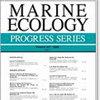Seasonal growth and calcification of three species of crustose coralline algae in Moorea, French Polynesia
IF 2.2
3区 环境科学与生态学
Q2 ECOLOGY
引用次数: 0
Abstract
ABSTRACT: Crustose coralline algae (CCA) play a critical role in the ecology and resilience of coral reefs by contributing to reef carbonate production and facilitating coral recruitment. However, little is known about their rates of in situ growth and calcification, particularly at the species level. To investigate the spatial and seasonal dynamics of CCA growth and calcification, we deployed CCA fragments embedded within epoxy rings at 3 mo intervals over 15 mo across 2 reef habitats in Moorea (French Polynesia). We studied 3 species differing in their microhabitat preferences (exposed, subcryptic and cryptic). Annual net calcification rates were highest in the exposed species Porolithon cf. onkodes (0.51 g CaCO3 cm-2 yr-1), intermediate in the subcryptic species Neogoniolithon cf. megalocystum (0.16 g CaCO3 cm-2 yr-1) and lowest in the cryptic species Lithophyllum sp. (0.03 g CaCO3 cm-2 yr-1). Growth and/or calcification rates differed between time intervals for all species. However, no consistent seasonal pattern was observed. P. cf. onkodes and N. cf. megalocystum had higher marginal growth rates at the fore reef habitat relative to the back reef habitat. This difference coincided with a lower occurrence of epiphytes on their crusts in the fore reef, suggesting that species interaction may be an important spatial driver of CCA growth. Our results show that CCA growth and calcification is species-specific and spatially and temporally variable. They highlight the need to consider subcryptic and cryptic CCA in reef carbonate budgets and provide important baseline information to understand how CCA communities are responding to environmental changes.法属波利尼西亚穆雷阿岛三种甲壳珊瑚藻的季节性生长和钙化情况
摘要:甲壳珊瑚藻(CCA)有助于珊瑚礁碳酸盐的生成并促进珊瑚的新陈代谢,在珊瑚礁的生态学和恢复力方面发挥着至关重要的作用。然而,人们对它们的原地生长和钙化率知之甚少,特别是在物种水平上。为了研究 CCA 生长和钙化的空间和季节动态,我们在莫雷阿(法属波利尼西亚)的两个珊瑚礁栖息地,以 15 个月为间隔,每隔 3 个月部署一次嵌入环氧树脂环的 CCA 片段。我们研究了对微生境(暴露、亚隐蔽和隐蔽)偏好不同的 3 个物种。暴露物种 Porolithon cf. onkodes 的年净钙化率最高(0.51 g CaCO3 cm-2 yr-1),亚隐居物种 Neogoniolithon cf. megalocystum 的年净钙化率居中(0.16 g CaCO3 cm-2 yr-1),隐居物种 Lithophyllum sp. 的年净钙化率最低(0.03 g CaCO3 cm-2 yr-1)。所有物种的生长率和/或钙化率在不同时间段都有所不同。不过,没有观察到一致的季节性模式。与后礁栖息地相比,前礁栖息地的 P. cf. onkodes 和 N. cf. megalocystum 的边际生长率较高。这种差异与前礁结壳上附生植物较少的情况相吻合,表明物种间的相互作用可能是 CCA 生长的重要空间驱动因素。我们的研究结果表明,CCA的生长和钙化具有物种特异性和时空可变性。它们强调了在珊瑚礁碳酸盐预算中考虑亚隐性和隐性 CCA 的必要性,并为了解 CCA 群落如何应对环境变化提供了重要的基线信息。
本文章由计算机程序翻译,如有差异,请以英文原文为准。
求助全文
约1分钟内获得全文
求助全文
来源期刊

Marine Ecology Progress Series
环境科学-海洋学
CiteScore
5.30
自引率
8.00%
发文量
238
审稿时长
3 months
期刊介绍:
The leading journal in its field, MEPS covers all aspects of marine ecology, fundamental and applied. Topics covered include microbiology, botany, zoology, ecosystem research, biological oceanography, ecological aspects of fisheries and aquaculture, pollution, environmental protection, conservation, and resource management.
 求助内容:
求助内容: 应助结果提醒方式:
应助结果提醒方式:


